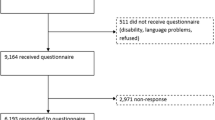Abstract
Background
Generic measures of quality of life have a wide application in health research. They measure disease impact by comparing scores in patient groups with a healthy population. They also facilitate comparative studies between different: patient groups. The SF-36 Health Survey quantifies respondents’ perceptions of their functioning in eight dimensions of daily life.
Aim
The aim of this study was to set normative values for the SF-36 in the Irish population aged 18 years and over.
Method
A random sample of 800 subjects was drawn from the electoral register using the RANSAM method of sampling.
Results
Two hundred and ninety five (37%) valid questionnaires were returned for analysis. The SF-36 was found to have acceptable internal consistency and validity. Normative values for the total population are presented, in addition to results for males and females across seven age groups. Ageing was associated with a decline in the physical dimensions of health.
Conclusions
There was no evidence to suggest that there were significant differences in health status between mates and females, or between this Irish sample and the published norms for the US population.
Similar content being viewed by others
References
WHO. Constitution of the World Health Organisation. In: World Health Organisation. Handbook of Basic Documents, 5th ed, Geneva, 1952; 2–30.
Slevin ML, Plant H, Lynch D, Drinkwater J, Gregory WM. Who should measure quality of life, the doctor or the patient?Br J Cancer 1988; 57: 109–112.
Guyatt GH, Feeney DH, Patrick DL. Measuring quality of life.Ann Int Med 1993; 118: 622–629.
Muldoon MF, Barger SD, Flory JD, Manuck SB. What are quality of life measurements measuring?BMJ 1998; 316: 542–545.
McDowell I, Newell C. The Theoretical and Technical Foundations of Health Measurement. In: Measuring Health: A Guide to Rating Scales and Questionnaires. 2nd ed. New York. Oxford University Press, 1996; 12–13.
Stewart AL, Greenfield S, Hays RD et al. Functional status and well-being of patients with chronic conditions.JAMA 1989; 262: 907–913.
Lohr KN, Brook RH, Kamberg CJ et al. Use of medical care in the Rand Health Insurance Experiment. Diagnosis and service-specific analyses in a randomised, controlled trial.Med Care 1986; 24 (suppl): S1-S87.
Ware JE. SF-36 Health Survey Manual and Interpretation Guide. Boston MA; Nimrod Press, 1993.
Tarlov AE, Ware JE Jr, Greenfield S, Nelson EC, Perrin E, Zubkoff M. The Medical Outcomes Study: an application of methods for monitoring the results of medical care.JAMA 1989; 262: 925–930.
Ware JE Jr, Kosinski M, Keller SD. SF-36 Physical and Mental Health Summary Scales: A Users’ Manual. Boston MA: Health Assessment Lab, 1994.
Brazier JE, Harper R, Jones NMB et al. Validating the SF-36 Health Survey questionnaire: new outcome measure for primary care.BMJ 1992; 305: 160–164.
Jenkinson C, Wright L, Coulter A. Criterion validity and reliability of the SF-36 in a population sample.Qual Life Res 1994; 3: 7–12.
Garratt AM, Ruta DA, Abdalla MI, Buckingham K, Russell IT. The SF-36 health survey questionnaire: an outcome measure suitable for routine use in the NHS?BMJ 1993; 306: 1440–1444.
McHorney CA, Ware JE, Lu JF, Sherbourne CD. The MOS 36-item shortform health survey (SF-36): III. Tests of data quality, scaling assumptions and reliability across diverse patient groups.Med Care 1994; 32: 40–66.
Khan IH, Garratt AM, Kumar A et al. Patient’s perception of health on renal replacement therapy: evaluation using a new instrument.Nephrol Dial Transplant 1995; 10: 684–689.
Hemingway H, Stafford M, Stansfield S, Shipley M, Marmot M. Is the SF-36 a valid measure of change in population health? Results from the Whitehall II study.BMJ 1997; 315: 1273–1279.
McDowell I, Newell C. General Health Status and Quality of Life. In: Measuring Health: A Guide to Rating Scales and Questionnaires, 2nd cd. New York. Oxford University Press, 1996; 446–456.
Jenkinson C, Layteo R, Wright L, Coulter A. The U.K. SF-36: An Analysis and Interpretation Manual. Oxford, UK: Oxford University Press, 1996; 40–41.
Central Statistics Office of Ireland. Census 1996 Preliminary Data. Dublin, Ireland: CSO, 1997.
Whelan BJ. Ransam: A random sample design for Ireland. Economic and Social Review 1979; 10: 169–174.
Keogh G, Whelan BJ. A Statistical Analysis of the Irish Electoral Register and its Use for Population Estimation and Sample Surveys. Dublin, Ireland: The Economic and Social Research Institute, 1986: 81–91.
Cronbach LJ, Warrington WG. Time limit tests: estimating their reliability and degree of speeding.Psychometrika 1951; 16: 167–168.
Central Statistics Office of Ireland. Quarterly National Household Survey, Statistical Release, February – April 1999, Dublin, Ireland: CSO, 1999.
McHorney CA, Kosinski M, Ware JE Jr, Comparisons of the costs and quality of norms for the SF-36 health survey collected by mail versus telephone interview: results from a national survey.Med Can 1994; 32: 551–567.
Andresen EM, Bowley N, Rothenberg BM, Panzer R, Katz P, Test-retest performance of a mailed version of the Medical Outcomes Study 36-item short-form heath survey among older adults,Med Care 1996; 34: 1165–1170.
Sackett DL. Bias in analytical research.J Chron Dis 1979; 32: 51–63.
Ware JE, Gandek B. Overview of the SF-36 health survey and the International Quality of Life Assessment (IQOLA) project.J Clin Epidemiol 1998; 51: 903–912.
Author information
Authors and Affiliations
Rights and permissions
About this article
Cite this article
Blake, C., Codd, M.B. & O’Meara, Y.M. The Short Form 36 (SF-36) Health Survey: normative data for the Irish population. Ir J Med Sci 169, 195–200 (2000). https://doi.org/10.1007/BF03167695
Issue Date:
DOI: https://doi.org/10.1007/BF03167695



